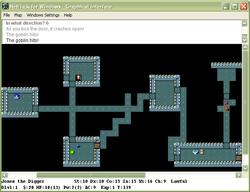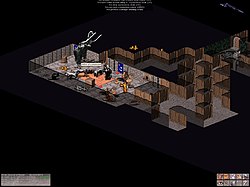NetHack: Difference between revisions
| Line 134: | Line 134: | ||
*''[[Vulture's Eye]]'' (a replacement for the abandoned ''[[Falcon's Eye]]'' project) offers a graphical [[Isometric projection|isometric]] view of the dungeon map. |
*''[[Vulture's Eye]]'' (a replacement for the abandoned ''[[Falcon's Eye]]'' project) offers a graphical [[Isometric projection|isometric]] view of the dungeon map. |
||
*Another graphical interface, ''[[noegnud]]'', allows text views, isometric views like ''[[Falcon's Eye]]'' as well as more advanced 3D interfaces. |
*Another graphical interface, ''[[noegnud]]'', allows text views, isometric views like ''[[Falcon's Eye]]'' as well as more advanced 3D interfaces. |
||
*''[[Slash'EM]]'' |
*''[[Slash'EM]]'' and ''SporkHack'' are more often updated [[Branching (software)|variants]] of ''NetHack''. |
||
* [[Porting|Ports]] also exist for the [[Nintendo DS]]<ref>{{cite web |url=http://stuartp.commixus.com/nhds/ |title=NetHack for the DS |accessdate=2007-11-29 |work=Stuart Pernsteiner's Website }}</ref>, [[PlayStation Portable]]<ref>{{cite web |url=http://www.feelthepawa.com/PSP/NetHack/ |title=Porting NetHack to the PSP - Latest news |accessdate=2007-11-29}}</ref>, [[Tapwave Zodiac]] [[Palm OS]]<ref>{{cite web |url=http://www.retrobits.net/palmos/nethack.shtml |title=NetHack and SlashEM for Palm OS |accessdate=2007-11-29 |work=Retrobits.net }}</ref>, [[GP2X]], [[Windows Mobile]]<ref>{{cite web |url=http://handheld.softpedia.com/get/Games/Adventure/NetHack-9837.shtml |title=Download NetHack 3.4.3 for Windows Mobile PocketPC - Softpedia |accessdate=2007-11-29 |work=Softpedia }}</ref>, and [[Nokia N800]] |
* [[Porting|Ports]] also exist for the [[Nintendo DS]]<ref>{{cite web |url=http://stuartp.commixus.com/nhds/ |title=NetHack for the DS |accessdate=2007-11-29 |work=Stuart Pernsteiner's Website }}</ref>, [[PlayStation Portable]]<ref>{{cite web |url=http://www.feelthepawa.com/PSP/NetHack/ |title=Porting NetHack to the PSP - Latest news |accessdate=2007-11-29}}</ref>, [[Tapwave Zodiac]] [[Palm OS]]<ref>{{cite web |url=http://www.retrobits.net/palmos/nethack.shtml |title=NetHack and SlashEM for Palm OS |accessdate=2007-11-29 |work=Retrobits.net }}</ref>, [[GP2X]], [[Windows Mobile]]<ref>{{cite web |url=http://handheld.softpedia.com/get/Games/Adventure/NetHack-9837.shtml |title=Download NetHack 3.4.3 for Windows Mobile PocketPC - Softpedia |accessdate=2007-11-29 |work=Softpedia }}</ref>, and [[Nokia N800]] |
||
Revision as of 20:09, 10 December 2007
 A released djinni grants the player a wish. | |
| Developer(s) | The NetHack DevTeam |
|---|---|
| Stable release | 3.4.3
/ December 8, 2003 |
| Repository | |
| Operating system | Cross-platform |
| Type | Roguelike game |
| License | NetHack General Public License |
| Website | www.nethack.org |
NetHack is a single-player roguelike computer game originally released in 1987. It is an evolution of an earlier game called Hack (1985), which was an evolution of Rogue (1980). The "net" element references that its development has been coordinated through the Internet[1]. The "hack" element refers to a genre of role-playing games known as hack and slash for their focus on combat. The player takes the part of a dungeon-diving character in search of the Amulet of Yendor. The dungeon spans over 50 levels, most of which are randomly generated.
NetHack is open source and one of the oldest computer games still being actively developed, with new features and bug fixes regularly being added by a loose but secretive group of volunteer developers, commonly called the DevTeam.
NetHack is traditionally played using text mode graphics where the dungeon's features, inhabitants, and items are all represented by single ASCII characters. There are also several graphical user interfaces available for the game.
Game
Before playing the game, the player is asked to name his or her character and then select a race, role, gender, and alignment for his or her character, or allow the game to create a random character. There are traditional character roles such as knight, wizard, rogue, valkyrie, and samurai, but there are also unusual ones, including archeologist, tourist, and caveman. The player's character class and alignment dictate which deity the player serves in the game.
After the player's character is created, the task is then introduced. To win the game, the player must find the Amulet of Yendor and sacrifice it to his or her deity. The Amulet is found at the lowest level of the dungeon. Successful completion of this main task rewards the player with the gift of immortality (the player is said to "ascend"), and the player attains the status of demigod. In addition to the main quest to find and sacrifice the Amulet, a number of sub-quests must be completed along the way, including one class-specific quest.
The player's character is usually accompanied by a pet animal, typically a kitten or little dog, although knights begin with a pony.
Players sometimes use the acronyms "YAAD" and "YASD" when discussing their characters' deaths, meaning "Yet Another Annoying Death" or "Yet Another Stupid Death". An "annoying" death is typically one that was the fault of misfortune more than the player (such as falling into a spiked, poisoned pit trap early in the game); a "stupid" death is when player's actions were directly responsible for their own death. Like roguelikes in general, NetHack features permadeath: expired characters can't be revived without having made backup copies of the actual save files.

The prompt "Do you want your possessions identified?" (abbreviated as "DYWYPI" and used to suggest character death) is given by default at the end of any game, allowing the player to learn any unknown properties of the items found during the game.
Sporadically, the game saves the level on which a character has died, and then integrates that level into a later dungeon, complete with the ex-player's possessions, ghost and killer(s). This is done via "bones files", which are saved on the computer hosting the game. A player using a publicly-hosted copy of the game can thus encounter the remains of many other players. Players can also swap bones files via programs like Hearse.[2]
Bugs, humorous messages, stories, experiences, and ideas for the next version are discussed on the Usenet newsgroup rec.games.roguelike.nethack[3].
Dungeon Levels
Most of the NetHack dungeon levels are randomly generated when the main character first encounters them. A typical level contains a way "up" and a way "down" (these may be stairways, ladders, trapdoors etc.) Some "special" levels are of fixed design in every game.
Items and tools
NetHack features a variety of items: armor to protect the player; scrolls and spellbooks to cast; potions to quaff; and an assortment of tools such as keys and lamps. Although the majority of items are beneficial to the player, the specific use of each item is unknown until the player identifies it.
Blessings and curses

As in many other roguelike games, all items in NetHack are either "blessed", "uncursed", or "cursed". The majority of items are found uncursed, but the "b/u/c" (blessed/uncursed/cursed) status of an item is unknown until it is identified or detected through other means.
A blessing makes the item more powerful, or less harmful in the case of items such as a scroll of punishment. Cursed items, on the other hand, cause ill or unintended effects, for example wearable items can no longer be removed until they have been uncursed.
Voluntary conducts
Experienced players of NetHack often attempt "conducts", which are voluntary restrictions on their behavior tracked by the game, to increase the difficulty further. Some conducts are not tracked by the game, but remain popular, such as speedrunning (making it through the dungeon within a set number of turns) and chastity (not using incubi or succubi to gain experience). Other challenges include not using items, such as wearing no armor.
Spoiler files
Extensive unofficial documentation exists for NetHack[4] Gleaning spoiler information from the source code is known as "source-diving". The documents are collectively known as "spoilers".
Interface
NetHack was originally created without a graphical user interface, although the option to play using one was added later in its development. The game's interface, environment, entities and objects, are all created or represented by arrangements of ASCII or Extended_ascii character sets used in the "DECgraphics" and "IBMgraphics" modes. In addition the environment, the interface also displays character and situational information.
Tiles mode

Apart from the original text mode, there are interfaces that replace text mode screen representations with images, or tiles, to represent the objects in the game. This is known as "tiles mode". Graphic interfaces include those using X11 tiled and the similar Windows graphical interface, the Qt toolkit, and the GNOME libraries. There are also enhanced graphical interfaces such as the isometric SDL-based Falcon's Eye, Vulture's Eye and noegnud.
Development
 |
NetHack's developers do not publicly discuss versions in progress, and they release new versions without notice. However, they do maintain a list of known bugs. Often, unofficial patches will be released by others between versions.
Other versions & interfaces
Even though many experienced NetHack players prefer the original text mode interface, several graphical user interfaces exist for NetHack.

- Vulture's Eye (a replacement for the abandoned Falcon's Eye project) offers a graphical isometric view of the dungeon map.
- Another graphical interface, noegnud, allows text views, isometric views like Falcon's Eye as well as more advanced 3D interfaces.
- Slash'EM and SporkHack are more often updated variants of NetHack.
- Ports also exist for the Nintendo DS[5], PlayStation Portable[6], Tapwave Zodiac Palm OS[7], GP2X, Windows Mobile[8], and Nokia N800
See also
References
- ^ "NetHack 3.4.3: Information". NetHack. Retrieved 2007-11-29.
- ^ "Hearse". Retrieved 2007-11-29.
- ^ "Rec.games.roguelike.nethack - Wikihack - a Wikia wiki". Wikihack. Retrieved 2007-11-29.
- ^ "Open Directory - Games: Video Games: Roleplaying: Rogue-like: NetHack: Cheats and Hints". Open Directory Project. Retrieved 2007-11-29.
- ^ "NetHack for the DS". Stuart Pernsteiner's Website. Retrieved 2007-11-29.
- ^ "Porting NetHack to the PSP - Latest news". Retrieved 2007-11-29.
- ^ "NetHack and SlashEM for Palm OS". Retrobits.net. Retrieved 2007-11-29.
- ^ "Download NetHack 3.4.3 for Windows Mobile PocketPC - Softpedia". Softpedia. Retrieved 2007-11-29.
External links
- Official
- Reviews
- Wikis
- Spoilers
